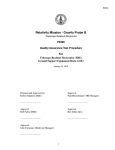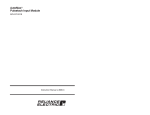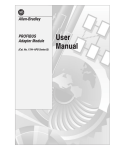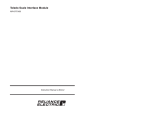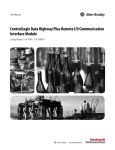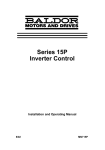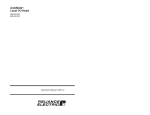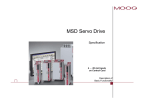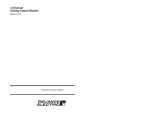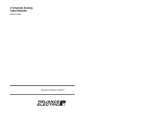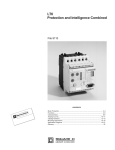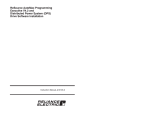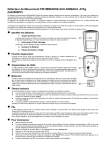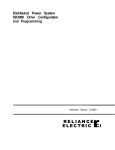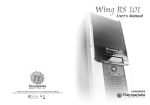Download J-3673-3 2-In/2-Out 4-20 mA Analog Rail Module
Transcript
The information in this user's manual is subject to change without notice. WARNING ONLY QUALIFIED ELECTRICAL PERSONNEL WHO ARE FAMILIAR WITH THE CONSTRUCTION AND OPERATION OF THIS EQUIPMENT AND THE HAZARDS INVOLVED SHOULD INSTALL, ADJUST, OPERATE, AND/OR SERVICE THIS EQUIPMENT. READ AND UNDERSTAND THIS MANUAL IN ITS ENTIRETY BEFORE PROCEEDING. FAILURE TO OBSERVE THIS PRECAUTION COULD RESULT IN SEVERE BODILY INJURY. WARNING INSERTING OR REMOVING THIS PRODUCT OR ITS CONNECTING CABLES MAY RESULT IN UNEXPECTED MACHINE MOTION. POWER TO THE MACHINE SHOULD BE TURNED OFF BEFORE INSERTING OR REMOVING THE PRODUCT OR ITS CONNECTING CABLES. FAILURE TO OBSERVE THIS PRECAUTION COULD RESULT IN BODILY INJURY. AutoMax, AutoMate, and Reliance are registered trademarks of Reliance Electric ąąCompany or its subsidiaries. Belden is a registered trademark of Belden, Inc. Table of Contents 1.0 Introduction . . . . . . . . . . . . . . . . . . . . . . . . . . . . . . . . . . . . . . . . . . . . . . . 1Ć1 1.1 Additional Information . . . . . . . . . . . . . . . . . . . . . . . . . . . . . . . . . . . . 1Ć1 1.2 Related Hardware and Software . . . . . . . . . . . . . . . . . . . . . . . . . . . 1Ć2 2.0 Mechanical/Electrical Description . . . . . . . . . . . . . . . . . . . . . . . . . . . 2Ć1 2.1 Mechanical Description . . . . . . . . . . . . . . . . . . . . . . . . . . . . . . . . . . . 2Ć1 2.2 Electrical Description . . . . . . . . . . . . . . . . . . . . . . . . . . . . . . . . . . . . . 2Ć3 3.0 Installation . . . . . . . . . . . . . . . . . . . . . . . . . . . . . . . . . . . . . . . . . . . . . . . . 3.1 Wiring . . . . . . . . . . . . . . . . . . . . . . . . . . . . . . . . . . . . . . . . . . . . . . . . . . 3.2 InitialăInstallation . . . . . . . . . . . . . . . . . . . . . . . . . . . . . . . . . . . . . . . . 3.3 Module Replacement . . . . . . . . . . . . . . . . . . . . . . . . . . . . . . . . . . . . . 3Ć1 3Ć1 3Ć2 3Ć6 4.0 Programming . . . . . . . . . . . . . . . . . . . . . . . . . . . . . . . . . . . . . . . . . . . . . . 4.1 Analog Rail Module in AutoMate Systems . . . . . . . . . . . . . . . . . . . 4.1.1 Configuring the AutoMate Processor for Use with the Analog Rail Module . . . . . . . . . . . . . . . . . . . . . 4.1.2 AutoMate Programming in Rail Mode . . . . . . . . . . . . . . . . . 4.1.3 AutoMate Programming in Local Head Mode . . . . . . . . . . 4.1.4 Analog In (AIN) and Analog Out (AOUT) Instruction Blocks . . . . . . . . . . . . . . . . . . . . . . . . . . . . . . . . . . 4.2 Analog Rail Module in DCS 5000/AutoMax Systems . . . . . . . . . . 4.2.1 Configuring the Analog Rail Module with a DCS 5000/AutoMax Remote I/O Head . . . . . . . . . . . . . . . . 4.2.2 Configuring the Analog Rail Module with a Power Module Interface Processor Host . . . . . . . . . . . . . . . 4.2.3 DCS 5000/AutoMax Programming . . . . . . . . . . . . . . . . . . . . 4Ć1 4Ć1 4Ć11 4Ć11 Diagnostics and Troubleshooting . . . . . . . . . . . . . . . . . . . . . . . . . . . . 5.1 Both LEDs on the Faceplate are Off . . . . . . . . . . . . . . . . . . . . . . . . 5.2 The COM OK" LED is Off . . . . . . . . . . . . . . . . . . . . . . . . . . . . . . . . . 5.3 Incorrect Data . . . . . . . . . . . . . . . . . . . . . . . . . . . . . . . . . . . . . . . . . . . 5.4 Constant UnderĆRange . . . . . . . . . . . . . . . . . . . . . . . . . . . . . . . . . . . 5Ć1 5Ć1 5Ć3 5Ć3 5Ć4 5.0 4Ć2 4Ć7 4Ć8 4Ć9 4Ć10 4Ć10 I Figure 1.1 Ć Analog Rail Module Hardware Configuration . . . . . . . . . . . . . . 1Ć3 Figure 2.1 Figure 2.2 Figure 2.3 Ć Analog Rail Module Faceplate . . . . . . . . . . . . . . . . . . . . . . . . . . 2Ć2 Ć Typical Output Circuit . . . . . . . . . . . . . . . . . . . . . . . . . . . . . . . . . . 2Ć4 Ć Typical Input Circuit . . . . . . . . . . . . . . . . . . . . . . . . . . . . . . . . . . . 2Ć4 Figure 3.1 Figure 3.2 Ć Mounting Dimensions . . . . . . . . . . . . . . . . . . . . . . . . . . . . . . . . . 3Ć2 Ć Typical Recommended Input and Output Shielding Methods . . . . . . . . . . . . . . . . . . . . . . . . . . . . . . . . . . . . . . . . . . . . . 3Ć5 Figure 4.1 Figure 4.2 4Ć1 Ć Input Signal Conversion . . . . . . . . . . . . . . . . . . . . . . . . . . . . . . . Ć Configuration for Analog Rail Module with AutoMate 20 . . . . . . . . . . . . . . . . . . . . . . . . . . . . . . . . . . . . . Figure 4.3 Ć Sample Configurations for Analog Rail Module Connected Directly to AutoMate 30 or 40 . . . . . . . . . . . . . . . . . Figure 4.4 Ć Sample Configuration for Analog Rail Module Connected to AutoMate 30 or 40 Through Local I/O Head . . . . . . . . . . . . Figure 4.5 Ć Sample Configuration for Analog Rail Module with AutoMate Local I/O Processor . . . . . . . . . . . . . . . . . . . . . . . . . . Figure 4.6 Ć Sample Configuration for Analog Rail Module with AutoMate Remote I/O Head . . . . . . . . . . . . . . . . . . . . . . . . . . . . Figure 4.7 Ć Rail Mode Register Image for Input Channels . . . . . . . . . . . . . Figure 4.8 Ć Rail Mode Register Image for Output Channels . . . . . . . . . . . Figure 4.9 Ć Local Head Mode Register Image for Input Channels . . . . . . Figure 4.10 Ć Local Head Mode Register Image for Output Channels . . . . Figure 4.11 Ć AIN Instruction Block . . . . . . . . . . . . . . . . . . . . . . . . . . . . . . . . . . Figure 4.12 Ć AOUT Instruction Block . . . . . . . . . . . . . . . . . . . . . . . . . . . . . . . . Figure 5.1 Figure 5.2 4Ć2 4Ć3 4Ć4 4Ć5 4Ć6 4Ć7 4Ć7 4Ć8 4Ć8 4Ć9 4Ć10 Ć Disassembling the Module to Replace the 32mA Fuse . . . . . 5Ć5 Ć Replacing the 32mA Fuse . . . . . . . . . . . . . . . . . . . . . . . . . . . . . . 5Ć6 III fafadfdfdasfdsfdsdsdfdsfdsfdsfsdfdsa afdfdsfdsfdfdsfdsfsadfda asfdfaddfdd 1.0 INTRODUCTION The products described in this instruction manual are manufactured by Reliance Electric Industrial Company. The 2ĆIn/2ĆOut 4Ć20mA Analog Rail module allows you to connect two input and two output 4Ć20mA analog signals to AutoMater, AutoMaxr and DCS 5000 systems. Typically, the Analog Rail module is used with potentiometers, valve actuators, pressure or flow transducers, and meters in both drive control systems and process control systems. The Analog Rail module is hardwareĆconfigurable by means of a faceplate switch to emulate one of two types of devices, AutoMate Rails or AutoMate Local Heads. In some hardware configurations, the type of interface device available for the Analog Rail module will determine the mode of operation that can be selected (see figure 1.1). The Analog Rail module operates in Local Head mode when it is connected directly to one of the processor's four I/O ports in AutoMate systems, to an AutoMate Local I/O Processor, or to one of the four I/O ports of the DCS 5000/AutoMax Remote I/O Head in DCS 5000/AutoMax systems. The Analog Rail data will take up four registers in the host when operating in Local Head mode. The module operates in Rail mode when it is connected to one I/O port of a Local I/O Head, which in turn is connected to one I/O port of an AutoMate processor. The Analog Rail module will occupy one register of the host in Rail mode. The Rail mode is used to expand the I/O address space available through the front I/O port of the processor by multiplexing each group of four analog points through one register. Note that the Analog Rail module cannot be used with the Local I/O Head in DCS 5000/AutoMax systems. The Analog Rail module operates in Rail mode when it is connected to one I/O port of the Power Module Interface (PMI) Processor (B/M 60000), which is in turn connected to a Universal Drive Controller (UDC) module (M/N 57552) which resides in an AutoMax rack. The remainder of this manual describes the functions and specifications of the module. It also includes a detailed overview of installation and troubleshooting procedures, as well as examples of configuration and programming. 1.1 Additional Information You must become familiar with the instruction manuals which describe your system configuration. This may include, but is not limited to, the following: D JĆ3031 AutoMate 30 PROCESSOR HARDWARE INSTRUCTION MANUAL D JĆ3033 AutoMate LOCAL I/O PROCESSOR INSTRUCTION MANUAL D JĆ3037 AutoMate REMOTE I/O HEAD INSTRUCTION MANUAL D JĆ3063 AutoMate PROGRAMMING EXECUTIVE INSTRUCTION MANUAL 1Ć1 JĆ3120 AutoMate 20 USER'S MANUAL JĆ3141 AutoMate 40 CONTROL PROCESSOR INSTRUCTION MANUAL JĆ3150 AutoMate 30/40 SOFTWARE REFERENCE MANUAL JĆ3649 DCS 5000/AutoMax CONFIGURATION TASK INSTRUCTION MANUAL JĆ3630 AutoMax PROGRAMMING EXECUTIVE INSTRUCTION MANUAL JĆ3600 DCS 5000 ENHANCED BASIC LANGUAGE INSTRUCTION MANUAL JĆ3675 AutoMax ENHANCED BASIC LANGUAGE INSTRUCTION MANUAL JĆ3601 DCS 5000 CONTROL BLOCK LANGUAGE INSTRUCTION MANUAL JĆ3676 AutoMax CONTROL BLOCK LANGUAGE INSTRUCTION MANUAL JĆ3602 DCS 5000 CONTROL BLOCK LANGUAGE INSTRUCTION MANUAL JĆ3677 AutoMax LADDER LOGIC LANGUAGE INSTRUCTION MANUAL JĆ3671 AutoMate LOCAL I/O HEAD INSTRUCTION MANUAL JĆ3750 ReSource AutoMax PROGRAMMING EXECUTIVE INSTRUCTION MANUAL VERSION 3.0 J2Ć3045 AutoMax PROGRAMMING EXECUTIVE VERSION 3.3 SĆ3006 DĆC DRIVE CONFIGURATION AND PROGRAMMING INSTRUCTION MANUAL SĆ3008 POWER MODULE INTERFACE RACK INSTRUCTION MANUAL Your personal computer and DOS operating system manual(s). IEEE 518 GUIDE FOR THE INSTALLATION OF ELECTRICAL EQUIPMENT TO MINIMIZE ELECTRICAL NOISE INPUTS TO CONTROLLERS 1Ć2 The 2ĆIn/2ĆOut 4Ć20mA Analog Rail module, M/N 61C351, contains the following: 1. One 2ĆIn/2ĆOut 4Ć20mA Analog Rail module 2. One I/O Rail cable: M/N 45C5 3. Two plug connectors: 12Ćpoint connector part no. 419434Ć2R ă4Ćpoint connector part no. 419434Ć1R 4. One .25A fuse (installed in the module): part no. 64676Ć23J 5. One .75A fuse (required for operation on 24 VDC): part no. 64676Ć23Q 6. Two cable retainer clips 7. Two 32mA fuses (installed in the module): part no. 64676Ć44A 8. Two spare 32mA fuses: part no. 64676Ć44A The Analog Rail module can be configured with the hardware (purchased separately) listed in figure 1.1. DCS 5000/AutoMax Remote I/O Head M/N 57C330 Local Head AutoMate 20, 20E M/N 45C20, 45C21, 45C220, 45C221, 45C224, 45C225 Local Head or Rail * AutoMate 30, 30E M/N 45C301, 45C305, 45C307 Local Head or Rail * AutoMate 40, 40E M/N 45C410, 45C411 Local Head or Rail * AutoMate Local I/O Processor M/N 45C200B (and later versions) Local Head AutoMate Remote I/O Head M/N 45C37, 45C38 Local Head Power Module Interface Processor B/M 60000 Rail * Direct connection to the Processors (Local Head mode) or connection through an AutoMate Local I/O Head, M/N 45C22, 61C22, 61C22A, or 61C23 (Rail mode). Note that it is also permissible to configure the Analog Rail module for Rail mode even if it is connected directly to an AutoMate 20, 30, or 40 Processor. Figure 1.1 Ć Analog Rail Module Hardware Configuration 1Ć3 fafadfdfdasfdsfdsdsdfdsfdsfdsfsdfdsa afdfdsfdsfdfdsfdsfsadfda asfdfaddfdd 2.0 MECHANICAL/ELECTRICAL DESCRIPTION The following sections describe the mechanical and electrical characteristics of the Analog Rail module. 2.1 Mechanical Description The Analog Rail module is a selfĆcontained electronic module containing two input channels multiplexed to an analogĆtoĆdigital converter and a dual digitalĆtoĆanalog converter for two output channels. The module is housed in a protective metal enclosure designed for panel mounting. See figure 2.1. 2Ć1 Analog Rail 61C351 4 to 20 mA IN/OUT Input PWR COM OK OK Local Head Mode Rail Analog I/O IĆOUT CH 0 CH 1 Common IĆOUT Common IĆIN CH 2 CH 3 Common IĆIN Common Input Power DCDC+ L2 L1 24 VDC 120 VAC Fuse Type 250V MDQ 24 VDC: Use 0.75A 120 VAC: Use 0.25A GND Figure 2.1 Ć Analog Rail Module Faceplate 2Ć2 The faceplate of the module contains three electrical connectors labeled Input", Analog I/O", and Input Power" (reading top to bottom). The top connector is used for connection to the I/O port. A cable (M/N 45C5) is provided for this purpose. The second connector, labeled Analog I/O", is a numbered, 12Ćpoint removable plug connector with screwĆtype terminal points. Three successive terminal points are reserved for each channel's connection to external hardware. The top 6 points are reserved for the two output channels (channel 0 and channel 1) and the bottom 6 are reserved for the two input channels (channel 2 and channel 3). The Analog I/O" terminals are designed for 14Ć22 AWG wire. The third connector on the faceplate, also a removable plug connector with screwĆtype terminal points, is used for input power. The terminal points are labeled. The top two points are used if the power source is 24 VDC. The bottom two points are used if the power source is 120 VAC. The Input Power" terminals are designed to use 14 AWG wire. A terminal stud for connecting a grounding conductor is provided on the bottom of the rightĆhand mounting flange. The module faceplate also contains two LEDs, a mode switch, and a fuse holder and fuse. The LED labeled PWR OK" indicates that the I/O port, the external power source, and the internallyĆgenerated voltages necessary for operation of the module are present. The COM OK" LED indicates whether all four channels are successfully communicating with the host. The switch labeled Mode" is used to select between Local Head" and Rail" mode. Note that the position of the switch is read only once at the time power is turned on to the Reliance device that is connected to the Analog Rail module. The mode will remain fixed as long as this device is powered up. As shipped from the factory, the fuse holder on the bottom of the faceplate contains a .25A fuse for 120 VAC input power. If input power will be 24 VDC, you need to replace the fuse with the .75A fuse included along with the Analog Rail module. 2.2 Electrical Description The Analog Rail module contains two analog input channels that convert 4Ć20mA analog input signals to proportional values between 0 and 4095, equal to 12 bits of digital data. Input channels are protected with a 32mA userĆreplaceable fuse. Input signals are filtered through a second order lowĆpass filter. The module also contains two output channels that can output 4Ć20mA analog signals proportional to an input value of 0 to 4095. A userĆsupplied power supply in series with the external hardware is required for the output channels. Note that at a digital output = 4096, the output rolls over to zero again. Negative output values cannot be accommodated. The A/D and D/A conversions are triggered by the actual I/O update sequences. The conversion rate is therefore dependent upon the scan time of the application task. See figure 2.2 for a typical output circuit. See figure 2.3 for a typical input circuit. 2Ć3 DAC RFB IĆOUT 0.416 2.083 V +10.000 V 104.167 I-OUT Figure 2.2 Ć Typical Output Circuit +10.000 V to A/D converter IĆIN 32 mA ( 250 ) 277.778 IĆCommon Figure 2.3 Ć Typical Input Circuit The Analog Rail module is factory calibrated and requires no offset/gain adjustment. All four analog I/O channels are referenced to the same common. This common is isolated from both the external power supply and the I/O port connection. The module incorporates extensive diagnostics. In Rail mode, check bits are monitored for accuracy on every transfer of data between the processor and the module. In Local Head mode, parity bits are monitored for accuracy on every transfer of data. A Rail fault LED on the processor, Remote Head, or Local Head will be illuminated if the check bits or parity bits are wrong and all transmission will stop after n retries, where n is a value determined by the host's software (average n = 4 for AutoMax; AutoMate n = 2). In the event of a rail fault, all outputs will be set to 0. The COM OK" LED on the module will go off. If any power required by the module, i.e., the +5 Volts from the I/O port required for communication, the external power supply, or the power required by the Analog I/O section, is not within specified limits, all outputs will be set to 0 and the PWR OK" LED will go off. 2Ć4 3.0 INSTALLATION This section describes how to install and replace the Analog Rail module. Note that analog signals are sensitive to variations in temperature. The Analog Rail module is designed to perform optimally at room temperature, approximately 25oC. In all cases, the ambient temperature of the installation must be maintained in the range specified in Appendix A to ensure the highest possible accuracy. DANGER THE USER IS RESPONSIBLE FOR CONFORMING WITH THE NATIONAL ELECTRICAL CODE AND ALL OTHER APPLICABLE LOCAL CODES. WIRING PRACTICES, GROUNDING, DISCONNECTS, AND OVERĆCURRENT PROTECTION ARE OF PARTICULAR IMPORTANCE. FAILURE TO OBSERVE THIS PRECAUTION COULD RESULT IN SEVERE BODILY INJURY OR LOSS OF LIFE. DANGER DO NOT TOUCH THE CONNECTORS ON THE FACEPLATE IF THERE IS POWER ON THE WIRES ATTACHED TO THE PLUG CONNECTOR SCREW TERMINALS. ALWAYS TURN OFF POWER BEFORE HANDLING A CONNECTOR THAT IS WIRED. FAILURE TO OBSERVE THIS PRECAUTION COULD RESULT IN SEVERE BODILY INJURY OR LOSS OF LIFE. WARNING UNEXPECTED OUTPUT CHANGES MAY RESULT IF AN ANALOG RAIL IS PLUGGED INTO A LOCAL I/O HEAD THAT IS COMMUNICATING WITH A PROCESSOR. ANY HARDWARE CONFIGURATION CHANGES MUST BE MADE ONLY WITH THE LOCAL I/O INTERFACE CABLE (M/N 45C8) DISCONNECTED. FAILURE TO OBSERVE THIS PRECAUTION COULD RESULT IN BODILY INJURY. CAUTION THE ANALOG RAIL MODULE IS DESIGNED TO BE POWERED BY EITHER 24 VDC OR 120 VAC. CONNECT THE PROPER POWER SOURCE TO THE MODULE. FAILURE TO OBSERVE THIS PRECAUTION COULD RESULT IN DAMAGE TO OR DESTRUCTION OF THE EQUIPMENT. 3.1 Wiring To reduce the possibility of electrical noise interfering with the proper operation of the control system, exercise care when installing the wiring between the module and the external hardware. Use shielded twisted pair for all wiring between the Analog Rail module and the external hardware. Belden 8761 or an equivalent cable type is recommended. For detailed recommendations refer to IEEE 518. 3Ć1 Use the following procedure to install the Analog Rail module. Step 1. Using the mounting dimensions shown in figure 3.1, prepare the necessary mounting provisions on the panel. The module is designed to be mounted vertically using four #10 or M5 bolts or studs. Multiple modules should be mounted side by side. The flange width of two modules side by side is sufficient to dissipate the heat produced by the modules. The modules can also be mounted one above the other, but since this hardware configuration does not allow the most efficient heat dissipation, the minimum clearance between the module chassis is 3". See figure 3.1. 2.44" 7.0" 9.25" 2.94" 3.0" Depth: 7.75" Diameter of mounting holes: 7/32" Figure 3.1 Ć Mounting Dimensions 3Ć2 Step 2. If the power supply you are using is 24 VDC, replace the factoryĆinstalled .25A fuse with the .75A fuse that came in the shipping box with the module. Use a screwdriver to release the fuse holder located on the Analog Rail module faceplate. Pull the fuse holder out of the module. Take the .25A fuse out of the fuse holder and replace it with the .75A fuse. ReĆinsert the fuse holder into the module. Turn the screwdriver clockwise while pressing down on the fuse holder. The fuse holder must be flush against the faceplate. Step 3. Mount the Analog Rail on the panel and attach it securely to the wall with #10 (M5) studs or bolts. Step 4. Make certain that no voltage is present on the wires that will be used to provide 120 VAC or 24 VDC power to the Analog Rail module. Use either a 120 VAC or 24 VDC power supply, but not both. Step 5. Using 14 AWG wire, connect input power to the screw terminals on the Input Power" plug connector on the faceplate as shown below. Strip off approximately 5/16" of insulation from the wires. 24 VDC Power Signal 24 VDC 24 VDC + Terminal Label DCDC+ Terminal Number 1 2 120 VAC Power Signal 120 VAC - (neutral) 120 VAC + (hot) Step 6. Terminal Label L2/N L1 Terminal Number 3 4 Use the stud marked GND" (ground) on the bottom right flange of the module to connect a ground wire. DANGER THE USER IS RESPONSIBLE FOR CONFORMING WITH THE NATIONAL ELECTRICAL CODE AND ALL OTHER APPLICABLE LOCAL CODES. WIRING PRACTICES, GROUNDING, DISCONNECTS, AND OVERĆCURRENT PROTECTION ARE OF PARTICULAR IMPORTANCE. FAILURE TO OBSERVE THIS PRECAUTION COULD RESULT IN SEVERE BODILY INJURY OR LOSS OF LIFE. Step 7. Turn off all power to any external hardware that will provide input signals to the module or be powered by the module. Step 8. Attach a retainer clip to the connector at each end of the I/O Rail cable (M/N 45C5). Note that faceplate connectors have slots that correspond to the part of the retainer clip that protrudes away from the cable connector. The retainer clip is used to assure a tight connection between the cable and faceplate connectors. Step 9. Using 14Ć22AWG wire, connect external hardware to the Analog I/O" plug connector on the faceplate as shown below. Strip off approximately 5/16" insulation from the wires. 3Ć3 0 1 2 3 IĆOUT Common (no label) 4-20mA+ output common (shield; no connection)* 1 4 5 6 IĆOUT Common (no label) 4-20mA+ output common (shield; no connection)* 2 7 8 9 IĆIN Common (no label) 4-20mA+ input common (shield; no connection)* 3 10 11 12 IĆIN Common (no label) 4-20mA+ input common (shield; no connection)* *This terminal makes no electrical connection to the Analog Rail printed circuit board. 3Ć4 Step 10. For each of the two output channels, connect a shield wire from the external hardware to the third terminal (terminals 3 and 6, respectively). The shield wire at the external hardware end of the cable should be connected to the source reference point. See figure 3.2. Step 11. For each of the two input channels, connect a shield wire from the external hardware to the third terminal (terminals 9 and 12, respectively). The shield wire at the external hardware end of the cable should be connected to the source reference point. See figure 3.2. Channel 0 IĆOut 1 Source Load - + Common 2 + - 3 Channel 1 IĆOut 4 Source Load - + Common 5 + - 6 Source Channel 2 IĆIn 7 Common 8 + - 9 Source Channel 3 IĆIn 10 Common 11 + - 12 Figure 3.2 Ć Typical Recommended Input and Output Shielding Methods Step 12. Turn off power to the Reliance device that will be connected to the Analog Rail module. Step 13. Set the Mode" switch on the faceplate of the Analog Rail module to the desired position. Step 14. Connect the I/O Rail cable between the Analog Rail connection labeled Input" and an I/O port on the Reliance device that will communicate with the module. Turn on power to the Reliance device that will communicate with the Analog Rail module. Recall that the Mode switch is read each time the Reliance device connected to the module is powered up. Step 15 The Analog Rail installation is now ready for testing. Inspect all work to assure that the installation has been performed properly. Step 16. Turn on power to the Input Power" wiring. Turn on power to the external hardware. Recall that external hardware being powered by the output of the Analog Rail module must be in series with an external power supply. See figure 3.2. See Appendix A for the power supply specifications. 3Ć5 Step 17. Verify that the hardware has been installed correctly. Before testing, insure that the external hardware will not respond to output signals from the Analog Rail module. WARNING BE CAREFUL WHEN WRITING TO THE OUTPUTS TO INSURE THAT NO UNEXPECTED MACHINE MOTION WILL RESULT. FAILURE TO OBSERVE THIS PRECAUTION COULD RESULT IN BODILY INJURY OR DAMAGE TO EQUIPMENT. For AutoMate systems, you must configure the AutoMate processor using the AutoMate Programming Executive (APX) before testing. See section 4.0 for more information. After configuring the module, use the APX Point Monitor function to test the module. You can test the Analog Rail module output channels by writing a value between 0 and 4095 to those channels and, with an ammeter, verifying that the output on the terminal points (4Ć20mA) is proportional. To test input channels, verify that the input signal in the channel (4Ć20mA) is proportional to an ammeter reading at the terminal points. For DCS 5000, AutoMax, or Distributed Power DĆC Drive systems, use the DCS 5000 or AutoMax Programming Executive software I/O Monitor function, respectively. Test output channels by writing a value between 0 and 4095 to those channels and using an ammeter to verify that the signal on the terminal points (4Ć20mA) is proportional. To test input channels, verify that the input signal in the channel (4Ć20mA) is proportional to a ammeter reading at the terminal points. 3.3 Module Replacement Use the following procedure to replace the module. 3Ć6 Step 1. Stop any application programs that are running. Step 2. Turn off power to the external hardware connected to the input and output channels on the faceplate of the module. Step 3. Turn off power to the Analog Rail module (120 VAC or 24 VDC). Step 4. Turn off power to the Reliance device connected to the Analog Rail module. Step 5. Disconnect the I/O Rail cable from the Analog Rail module. Step 6. Without disconnecting the wiring, remove the 12Ćpoint terminal from the faceplate and set aside. Step 7. Without disconnecting the wiring, remove the 4Ćpoint terminal from the faceplate and set aside. Disconnect the ground wire from the bottom of the rightĆhand flange. Step 8. Loosen the screws that hold the Analog Rail module to the panel and remove the module. Step 9. If the power supply you are using is 24 VDC, you need to replace the factoryĆinstalled .25A fuse in the new module with the .75A fuse that came in the shipping box with the module. Use a screwdriver to release the fuse holder located on the Analog Rail module faceplate. Pull the fuse holder out of the module. Remove the .25A fuse from the fuse holder and replace it with the .75A fuse. ReĆinsert the fuse holder into the module. Turn the screwdriver clockwise while pressing down on the fuse holder at the same time. The fuse holder must be flush against the faceplate. Step 10. Remove the two plug connectors from the faceplate of the new module by pulling them firmly away from the faceplate. Step 11. Place the new module over the pattern drilled and attach it securely to the panel with #10 or M5 studs or bolts. Step 12. Attach the original 12Ćpoint and 4Ćpoint connectors with wiring to the faceplate of the module. Use the stud marked GND" (ground) on the bottom right flange of the module to connect a ground wire. Step 13. Set the Mode" switch on the faceplate to the desired position. Step 14. Connect the I/O Rail cable between the Analog Rail connection labeled Input" and the I/O port. Turn on power to the Reliance device connected to the Analog Rail module. Recall that the Mode switch is read each time the Reliance device connected to the module is powered up. If applicable, reĆconnect the cable between the Local I/O Head, or the DCS 5000 Remote I/O Head, and the host. Step 15. Turn on power to the Analog Rail module Input Power" connections. Step 16. Turn on power to the external hardware connected to the Analog Rail module. Step 17. Verify that the hardware has been installed correctly. Before testing, insure that the external hardware cannot respond to output signals from the Analog Rail module. WARNING BE CAREFUL WHEN WRITING TO THE OUTPUTS TO INSURE THAT NO UNEXPECTED MACHINE MOTION WILL RESULT. FAILURE TO OBSERVE THIS PRECAUTION COULD RESULT IN BODILY INJURY OR DAMAGE TO EQUIPMENT. For AutoMate systems, use the APX Point Monitor function to test the module. You can test the Analog Rail module output channels by writing a value between 0 and 4095 to those channels and, with an ammeter, verifying that the output on the terminal points (4Ć20mA) is proportional. To test input channels, verify that the input signal in the channel (4Ć20mA) is proportional to an ammeter reading at the terminal points. 3Ć7 For DCS 5000, AutoMax, or Distributed Power DĆC Drive systems, use the DCS 5000 or AutoMax Programming Executive software I/O Monitor function, respectively. Test output channels by writing a value between 0 and 4095 to those channels and using an ammeter to verify that the signal on the terminal points (4Ć20mA) is proportional. To test input channels, verify that the input signal in the channel (4Ć20mA) is proportional to an ammeter reading at the terminal points. 3Ć8 This section describes how the data is organized in the module and provides examples of how the module is accessed by application programs. When creating application programs, the programmer must estimate the magnitude of input signals and output data because both must be in the specified range of the Analog Rail module (4Ć20mA). Input signals greater than 20mA will be clamped at 4095. Signals greater than approximately 22.6mA will also cause the overĆrange bit (12 decimal; 14 octal) to be set to 1. Input signals less than 4mA are clamped at zero (0). Signals less than approximately 2.5mA will also cause the underĆrange bit (13 decimal; 15 octal) to be set to 1. See figure 4.1. Counts >22.6 = overĆrange 4095 0 4 <2.5 = underĆrange 20 mA Figure 4.1 Ć Input Signal Conversion Recall that at a digital output = 4096, the output rolls over to zero again. The programmer must include limits in the application software to ensure that the data sent to output channels is always in the specified range (allowable range = 0 to 4095). This section describes how the Analog Rail is used with AutoMate systems. Local Head mode allows all four channels on the module to be updated at the end of the scan (normal I/O update rate in this configuration), or during the scan using AIN and AOUT blocks (see section 4.1.4). Rail mode allows only one channel to be updated at the end of the scan (normal I/O update rate in this configuration), or all four channels to be updated during the scan if AIN and AOUT blocks are used. 4Ć1 Configuration is the process of describing in software how the hardware and software in the system are related. The Analog Rail module is configured using the AutoMate Programming Executive (APX) software, M/N 45C130 or 45C131. Select CONFIGURE SYSTEM from the main menu to create the configuration. Note that the Analog Rail module can also be configured using the AutoMate Programming System (APS) software, M/N 45C134, 45C141, 45C142, or 45C143. Refer to instruction manual J2Ć3041 for additional information. The Analog Rail module is configured depending upon the mode in which it is being used. See figures 4.2, 4.3, 4.4, 4.5, and 4.6 for how to configure the Analog Rail for use with AutoMate processors. The sample configurations are shown as they appear on the APX screen. Unless otherwise noted, all references to the AutoMate 20, 30, and 40 will also apply to the 20E, 30E and the 40E, respectively. Analog Rail Module with AutoMate 20 (Local Head Mode or Rail Mode) AutoMate 20 registers reserved for port configuration: 2734 2735 2736 2737 Port 0 of AutoMate 20 Port 1 of AutoMate 20 Port 2 of AutoMate 20 Port 3 of AutoMate 20 Local Head Mode Enter the value 64XX for the register representing the port to which the Analog Rail module is connected, where XX is a value from 00Ć14*. The XX value repreĆ sents the first register in a set of four contiguous registers that will be used to store data for the port. Rail Mode Enter the value 16XX for the register representing the port to which the Analog Rail module is connected, where XX is a value from 00Ć17*. The XX value repreĆ sents the register that will be used to multiplex data through the I/O port. *Values are in octal notation. Figure 4.2 Ć Configuration for Analog Rail Module with AutoMate 20 4Ć2 Analog Rail Module Connected Directly to AutoMate 30 or 40 (Local Head Mode or Rail Mode) The following sample configuration shows two Analog Rail modules connected directly to an AutoMate 30 or 40 Processor in Local Head mode: MSLT DROP TYP RSLT CARD CH0 REGISTER CH1 REGISTER CH2 REGISTER CH3 REGISTER ă1 A/M LHD ăă0Ć3 LHD ăă4Ć7 NU NU The following sample configuration shows two Analog Rail modules connected directly to an AutoMate 30 or 40 Processor in Rail Mode : MSLT DROP TYP RSLT CARD CH0 REGISTER CH1 REGISTER CH2 REGISTER CH3 REGISTER ă1 A/M RAIL ăăă0 RAIL ăăăă1 NU NU Figure 4.3Ć Sample Configurations for Analog Rail Module Connected Directly to AutoMate 30 or 40 4Ć3 Analog Rail Module Connected to AutoMate 30 or 40 Through a Local I/O Head (Rail Mode Only) The following sample configuration shows two Analog Rail modules connected to an AutoMate 30 or 40 through a Local I/O Head: MSLT DROP TYP RSLT CARD CH0 REGISTER CH1 REGISTER CH2 REGISTER CH3 REGISTER ă2 A/M LHD ăăă0Ć3 NU NU NU Figure 4.4 Ć Sample Configuration for Analog Rail Module Connected to AutoMate 30 or 40 Through Local I/O Head 4Ć4 Analog Rail Module with AutoMate Local I/O Processor (Local Head Mode Only) The following sample configuration shows three Analog Rail modules connected to a Local I/O Processor in a remote rack: MSLT DROP TYP RSLT CARD CH0 REGISTER CH1 REGISTER CH2 REGISTER CH3 REGISTER ă2 ă1 RRK ăă2 LIOP LHD ăăă0Ć3 LHD ăăă4Ć7 LHD ăă10Ć13 NU Figure 4.5 Ć Sample Configuration for Analog Rail Module with AutoMate Local I/O Processor 4Ć5 Analog Rail Module with AutoMate Remote I/O Head (Local Head Mode Only) The following sample configuration shows one Analog Rail module connected to an AutoMate Remote I/O Head: MSLT DROP TYP RSLT CARD CH0 REGISTER CH1 REGISTER CH2 REGISTER CH3 REGISTER ă1 ă0 RHD LHD ăăă0Ć3 NU NU NU Figure 4.6 Ć Sample Configuration for Analog Rail Module with AutoMate Remote I/O Head 4Ć6 In Rail mode, the Analog Rail module is imaged in one I/O register of the processor. Data from one of the four channels will occupy the register as a function of the channel select bits. The active channel is updated at the end of each scan. For input channels, the two channel select bits in the register must be set to the appropriate input channel number. After the I/O update, the register contains the data in the format shown in figure 4.7. For output channels, the data in the register must be in the format shown in figure 4.8 prior to the I/O update. Octal MSB LSB ăCH# ă0ąą0 = CH 0 ă0ąą1 = CH 1 ă1ąą0 = CH 2 ă1ąą1 = CH 3 17 16 15 14 13 12 11 10 7 6 5 4 3 2 1 0 1 0 12 bits of converted analog data overĆrange (1=overĆrange) underĆrange (1=underĆrange) channel being read: LSB channel being read: MSB Figure 4.7 Ć Rail Mode Register Image for Input Channels Octal MSB LSB ăCH# ă0ąą0 = CH 0 ă0ąą1 = CH 1 ă1ąą0 = CH 2 ă1ąą1 = CH 3 17 16 15 14 13 12 11 10 7 6 5 4 3 2 12 bits of analog output data not used not used channel being modified: LSB channel being modified: MSB Figure 4.8 Ć Rail Mode Register Image for Output Channels The Analog Rail module data may also be accessed in the middle of the scan (as opposed to the end of the scan, which is the normal mode of operation for digital rail I/O) using the appropriate number of Analog In (AIN) and Analog Out (AOUT) blocks. The AIN block will check whether the overĆrange or underĆrange bits have been set by the module and the error coil will be energized, if applicable. The AOUT block will set the channel select bits appropriately. See section 4.1.4 for more information about the AIN and AOUT blocks. Note that the AIN and AOUT blocks are supported by the AutoMate 20E M/N 45C224 and 45C225, but not the AutoMate 20 (M/N 45C20, 45C21, 45C220, 45C221) by APX Version 3.0. 4Ć7 For processors that do not support the AIN and AOUT blocks, you can use the MOVE block to move data in and out of the registers assigned and to determine the channel select bits. OverĆrange and underĆrange bits should be used as inputs to error coils. The I/O update will occur automatically at the end of each scan. See Appendix C for a sample AutoMate program that writes to and reads from the Analog Rail module without using AIN and AOUT blocks. In Local Head mode, the module is imaged in four I/O registers of the processor. Data from all four channels is always available and will be updated at the end of each scan. For input channels, it is not necessary to select the channel. After the I/O update, the register contains the data in the format shown in figure 4.9. For output channels, the data in the register must be in the format shown in figure 4.10 prior to the I/O update. Octal 17 16 15 14 13 12 11 10 7 6 5 4 3 2 1 0 12 bits of converted analog data overĆrange (1=overĆrange) underĆrange (1=underĆrange) not used not used Figure 4.9 Ć Local Head Mode Register Image for Input Channels Octal 17 16 15 14 13 12 11 10 7 6 5 4 3 2 1 0 12 bits of analog output data not used not used not used not used Figure 4.10 Ć Local Head Mode Register Image for Output Channels The Analog Rail module data may also be accessed in the middle of the scan (as opposed to the end of the scan) using the appropriate number of Analog In (AIN) and Analog Out (AOUT) blocks. The AIN block will set the overĆrange or underĆrange bits if applicable. See section 4.1.4 for more information about the AIN and AOUT blocks. Note that the AIN and AOUT blocks are supported by the AutoMate 20E (M/N 45C224 and 45C225), but not the AutoMate 20 (M/N 45C20, 45C21, 45C220, 45C221) by APX Version 3.0. 4Ć8 For processors that do not support the AIN and AOUT blocks, you can use the MOVE block to move data in and out of the registers assigned. OverĆrange and underĆrange bits should be used as inputs to error coils. The I/O update will occur automatically at the end of each scan. See Appendix C for a sample AutoMate program that writes to and reads from the Analog Rail module without using AIN and AOUT blocks. 4.1.4 Analog In (AIN) and Analog Out (AOUT) Instruction Blocks The AIN and AOUT blocks are used, respectively, to read inputs from and write outputs to the Analog Rail module. AIN and AOUT blocks are supported for the 20E processor. The AIN and AOUT blocks make it possible to update the channels on the Analog Rail module during the scan instead of at the end of the scan (the standard AutoMate I/O update). The blocks also make it possible to update all four channels during the scan in Rail mode, a hardware configuration which would otherwise allow only one channel on the module to be updated. The format of the two blocks is shown in figures 4.11 and 4.12. AIN Instruction Block The example below shows an AIN block for an Analog Rail module connected to port 2 of an AutoMate Processor. AIN 12 .01 [ ] EN AIN IOPORT: LHPORT: CHAN: DEST: VALUE: AutoMate 20E with ports 0, 1, 2, and 3 0 1 2 3 IOPORT Ć 2 0 3 2000 EN 13 .01 ( ) ER 76 .00 ( ) Analog Rail with channels 0, 1, 2, and 3 In Rail Mode Chan 0 Chan 1 Chan 2 Chan 3 Processor port to which the Analog Rail is connected (directly or indirectly); value range 0Ć3. LHPORT Ć Local I/O Head port to which the Analog Rail is connected; value range 0Ć3. If a Local I/O Head is not used, the value is 0. CHAN Ć Channels on the Analog Rail module to read; value range 2 or 3. DEST Ć Register number where the value of the channel is stored. Figure 4.11 Ć AIN Instruction Block 4Ć9 AOUT Instruction Block The example below shows an AOUT block for an Analog Rail module connected to port 2 of a Local I/O Head, which in turn is connected to port 3 of an AutoMate Processor. Data from register 2000 is used in this example. AOUT 13 12 .01 .01 EN EN ( ) [ ] AOUT SRC: VALUE: IOPORT: LHPORT: CHAN: AutoMate 20E with ports 0, 1, 2, and 3 0 1 2 3 Local Head with ports 0, 1, 2, and 3 2000 3 2 1 ER 76 .00 ( ) Analog Rail with channels 0, 1, 2, and 3 In Rail Mode 0 1 2 3 Chan 0 Chan 1 Chan 2 Chan 3 SRC Ć Register number from which the data to output will be taken. IOPORT Ć Processor port to which the Analog Rail is connected (directly or indirectly); value range 0Ć3. LHPORT Ć Local I/O Head port to which the Analog Rail is connected; value range 0Ć3. If a Local I/O Head is not used, the value is 0. CHAN Ć Channel on the Analog Rail module to write; value range 0 or 1. Figure 4.12 Ć AOUT Instruction Block 4.2 Analog Rail Module in DCS 5000/AutoMax Systems This section describes how the Analog Rail is used with DCS 5000/AutoMax systems. 4.2.1 Configuring the Analog Rail Module with a DCS 5000/AutoMax Remote I/O Head The Analog Rail module is used in the Local Head mode when the host is a DCS 5000/AutoMax Remote I/O Head. For AutoMax Version 3.0 and later, the Analog Rail module is configured using the AutoMax Programming Executive. Refer to instruction manual JĆ3750 for more information. For DCS 5000 or AutoMax Version 2.1 or earlier, the module is defined in the configuration task for the master rack using the DCS 5000 or AutoMax Programming Executive software. See instruction manual JĆ3649 for more information on the configuration task. 4Ć10 For DCS 5000 or AutoMax Version 2.1 or earlier, use the RIODEF statement to define each channel on the Analog Rail module as a separate register. Note that in addition to defining each channel as a register, you can also define the overĆrange and underĆrange bits for each channel separately. These bits can also be defined using the RIODEF statement. Use the following format for the RIODEF statement: nnnnn RIODEF name[MASTER_SLOT=m, DROP=d, SLOT=s, REGISTER=r, BIT=b] where: nnnnn Ć Configuration task line number; range 1Ć32767. name Ć Symbolic name of channel, ending with % (integer) for registers, @ (booleans) for bits. 4.2.2 m Ć Slot in rack containing DCS 5000/AutoMax master remote I/O module; range 0Ć15. d Ć Drop number of DCS 5000/AutoMax Remote I/O Head; range 1Ć7. s Ć Communication port on the DCS 5000/AutoMax Remote I/O Head to which the Analog Rail module is connected; range 0Ć3. r Ć Register number; range 0Ć3. b Ć Optional field defining the bit position within the register number; range 0Ć15. Configuring the Analog Rail Module with a Power Module Interface Processor Host The Analog Rail module is used in the Rail mode when the host is a Power Module Interface (PMI) Processor. Beginning with AutoMax Version 3.3, the Analog Rail module is configured using the AutoMax Programming Executive. Refer to instruction manual J2Ć3045 for more information. 4.2.3 DCS 5000/AutoMax Programming When programming the Analog Rail module, it is recommended that you monitor the state of the overĆrange and underĆrange bits for the input channels. You can check the status of the appropriate bits directly if they were defined in the configuration. You can also use the BASIC expression AND with the variable name assigned to the input channel to mask off the 12 bits of analog data and read the values in the overĆrange and underĆrange bits. Any nonĆzero result means that the value is out of range. See the following three statements for examples of how to detect values out of range. Use the hexadecimal values shown to mask off the analog data. The value in the channel defined as CHANNEL_2 is either overĆrange or underĆrange: 10000 RANGE_ERROR@ = CHANNEL_2 AND 3000H The value in the channel defined as CHANNEL_2 is overĆrange: 11000 OVER_ERROR@ = CHANNEL_2 AND 1000H The value in the channel defined as CHANNEL_2 is underĆrange: 12000 UNDER_ERROR@ = CHANNEL_2 AND 2000H 4Ć11 fafadfdfdasfdsfdsdsdfdsfdsfdsfsdfdsa afdfdsfdsfdfdsfdsfsadfda asfdfaddfdd 5.0 DIAGNOSTICS AND TROUBLESHOOTING DANGER THE REMAINING STEPS ARE MADE WITH POWER ON. EXERCISE EXTREME CAUTION BECAUSE HAZARDOUS VOLTAGE EXISTS. FAILURE TO OBSERVE THIS PRECAUTION COULD RESULT IN SEVERE BODILY INJURY OR LOSS OF LIFE. WARNING ONLY QUALIFIED ELECTRICAL PERSONNEL FAMILIAR WITH THE CONSTRUCTION AND OPERATION OF THIS EQUIPMENT AND THE HAZARDS INVOLVED SHOULD INSTALL, ADJUST, OPERATE, AND/OR SERVICE THIS EQUIPMENT. READ AND UNDERSTAND THIS MANUAL IN ITS ENTIRETY BEFORE PROCEEDING. FAILURE TO OBSERVE THIS PRECAUTION COULD RESULT IN BODILY INJURY. WARNING INSERTING OR REMOVING THIS PRODUCT OR ITS CONNECTING CABLES MAY RESULT IN UNEXPECTED MACHINE MOTION. POWER TO THE MACHINE SHOULD BE TURNED OFF BEFORE INSERTING OR REMOVING THE PRODUCT OR ITS CONNECTING CABLES. FAILURE TO OBSERVE THIS PRECAUTION COULD RESULT IN BODILY INJURY. This section explains how to troubleshoot the Analog Rail module. If you cannot correct the problem using the instructions below, the unit is not userĆserviceable. 5.1 Both LEDs on the Faceplate are Off Problem: The PWR OK" and COM OK" LEDs on the faceplate are off. This problem can indicate that the unit is not receiving the +5V from the processor or Local or Remote Head, the 120 VAC or 24 VDC from the external power supply, or both within the specified ranges. This problem can also indicate that the external power supply fuse (.75A or .25A) has blown or that the module is malfunctioning. Step 1. Stop any application programs or tasks that are running. Use a voltmeter to measure the input power (120 VAC or 24 VDC) to the module. Verify that the power source is providing 120 VAC or 24 VDC, whichever is appropriate. DANGER VOLTAGE IS PRESENT ON THE PLUG CONNECTOR TERMINALS. DISCONNECT THE POWER AT THE SOURCE BEFORE TOUCHING THE PLUG CONNECTOR TERMINALS. FAILURE TO OBSERVE THIS PRECAUTION COULD RESULT IN SEVERE BODILY INJURY OR LOSS OF LIFE. 5Ć1 DANGER DO NOT TOUCH THE CONNECTORS ON THE FACEPLATE IF THERE IS POWER ON THE WIRES ATTACHED TO THE PLUG CONNECTOR SCREW TERMINALS. ALWAYS TURN OFF POWER BEFORE HANDLING A CONNECTOR THAT IS WIRED. FAILURE TO OBSERVE THIS PRECAUTION COULD RESULT IN SEVERE BODILY INJURY OR LOSS OF LIFE. Step 2. Turn off power to the module. Verify that the input power connector is connected securely to the faceplate. Verify that the I/O Rail cable connections are tight at both ends. Step 3. Turn on power to the module. If LEDs are still off, try replacing the I/O Rail cable. Check that the pins on the input connector are not bent. Step 4. If the LEDs are still off, turn off power to the module and replace the power supply fuse on the front panel following the directions below. CAUTION MAKE CERTAIN THAT THE ANALOG RAIL MODULE CONTAINS THE PROPER FUSE FOR THE POWER SUPPLY BEING USED. USE A .25 A FUSE FOR 120 VAC POWER AND A .75A FUSE FOR 24 VDC POWER. FAILURE TO OBSERVE THIS PRECAUTION COULD RESULT IN DAMAGE TO OR DESTRUCTION OF THE EQUIPMENT. a) Use a screwdriver to release the fuse holder located on the Analog Rail module faceplate. Pull the fuse holder out of the module. b) Take the old fuse out of the fuse holder and replace it with the new fuse. Use a .25A fuse for 120 VAC power and a .75A fuse for 24 VDC power. See Appendix A for the fuse type and rating. c) ReĆinsert the fuse holder into the module. Turn the screwdriver clockwise while pressing down on the fuse holder. The fuse holder must be flush against the faceplate. Step 5. 5Ć2 Turn on power to the module. If both LEDs still do not light, replace the module. 5.2 The COM OK" LED is Off Problem: The COM OK" LED on the faceplate is off. This LED signifies whether there is communication between the Analog Rail and the host. The LED should be on if communication is taking place. The possible causes of this problem are incorrect configuration, a disconnected or malfunctioning I/O Rail cable, a malfunctioning host, or a malfunctioning Analog Rail module. After verifying that the configuration of the Analog Rail is correct, follow the steps below to isolate the problem. Step 1. Stop any application tasks or programs that are running and turn off power to the Analog Rail module. DANGER VOLTAGE IS PRESENT ON THE PLUG CONNECTOR TERMINALS. DISCONNECT THE POWER AT THE SOURCE BEFORE TOUCHING THE PLUG CONNECTOR TERMINALS. FAILURE TO OBSERVE THIS PRECAUTION COULD RESULT IN SEVERE BODILY INJURY OR LOSS OF LIFE. DANGER DO NOT TOUCH THE CONNECTORS ON THE FACEPLATE IF THERE IS POWER ON THE WIRES ATTACHED TO THE PLUG CONNECTOR SCREW TERMINALS. ALWAYS TURN OFF POWER BEFORE HANDLING A CONNECTOR THAT IS WIRED. FAILURE TO OBSERVE THIS PRECAUTION COULD RESULT IN SEVERE BODILY INJURY OR LOSS OF LIFE. 5.3 Step 2. Verify that the connections on both ends of the I/O Rail cable are tight. Check that the pins on the input connector are not bent. Step 3. Turn on power to the module. The COM OK" LED should be illuminated if communication is taking place. If the LED still does not illuminate, turn off power to the module and replace the I/O Rail cable. Step 4. If applicable, try to reset the condition by disconnecting and then reĆconnecting the cable between the host and the Local I/O Head, the AutoMate Remote I/O Head, or the DCS 5000/AutoMax Remote I/O Head. Troubleshoot the host if necessary. If the problem is still not corrected, replace the Analog Rail module. Incorrect Data Problem: The data (signal) being read or written is always on, always off, or different than expected. The possible causes of this problem are incorrect configuration, a programming error, a disconnected or malfunctioning I/O Rail cable, disconnected or malfunctioning wiring to the external hardware, malfunctioning external hardware or a malfunctioning Analog Rail module. After verifying that the configuration of the module is correct, follow the steps below to isolate the problem. Step 1. Verify that the application program(s) is correct. Check to see that the program is referencing the correct registers (AutoMate) or symbolic names (DCS 5000/AutoMax). 5Ć3 In DCS 5000/AutoMax applications, make certain that the program is not attempting to write to the input channels. Verify that the data being output is within the specified limits. Step 2. Stop any application tasks that are running. Turn off power to the Analog Rail module. Step 3. Try to clear the condition by disconnecting and then reconnecting the I/O Rail cable. Make certain the connections are tight. If applicable, check the connections between the host and the Local I/O Head, the AutoMate Remote I/O Head, or the DCS 5000/AutoMax Remote I/O Head. Check that the pins on the input connector are not bent. Step 4. Turn off power to the external hardware. Verify that the wiring to the external hardware is tight and functioning correctly. Step 5. Turn on power to the external hardware. Before testing, make certain that the external hardware cannot respond to outputs from the Analog Rail module. For input channels, use the Executive software to read the value on the input channels. Use an ammeter to read the input signal and compare the two. If the signal is being converted correctly, there is a problem with the external hardware or wiring. For output channels, use the Executive software to write a value between 0 and 4095 to each channel. Use an ammeter to verify that the signal on the terminal points is proportional to the value. If the signal is being converted correctly, there is a problem with the external hardware or wiring. Step 6. Troubleshoot the external hardware, the wiring, and the host. Problem: the underĆrange bit (12 decimal) on an input channel register is constantly set to 1. Assuming that the power supply for the external hardware connected to the input channel is providing an input signal within the specified limits (4Ć20mA), the possible causes of this problem are a loose connector on the analog I/O section of the faceplate, loose or malfunctioning wiring, incorrect (reversed) input signal wiring on the module faceplate, or a blown input channel fuse (32mA fuse). Follow the steps below to isolate the problem. 5Ć4 Step 1. Stop any application tasks that are running. Turn off power to the external hardware connected to the module. Turn off input power (120 VAC or 24 VDC) to the module. Step 2. Verify that the 12Ćpoint connector on the analog I/O section of the module faceplate is securely attached to its mating half. Step 3. Verify that the signal wiring on the module faceplate is correct. See step 9 in section 3.2 for more information. Verify that the wiring is tight and functioning properly. Step 4. Turn on power to the module and to the external hardware. Use the Executive software to read the value on the input channel. Use an ammeter to read the input signals at the terminal point and compare the two. If both read zero, verify that the external hardware is operating correctly. If the external hardware is operating correctly, the 32mA fuse for the input channel may be blown. Step 5. Replace the 32mA fuse(s) that has blown following the directions below. a) Stop any application tasks that are running. b) Turn off power to the external hardware connected to the module. Turn off power (120 VAC or 24 VDC) to the module. c) Without disconnecting the wiring, remove the 12Ćpoint connector from the faceplate and set aside. Without disconnecting the wiring, remove the 4Ćpoint connector from the faceplate and set aside. d) Before disassembling the module, note that it consists of two major pieces, the metal enclosure and the printed circuit board, which is screwed to the left side of the enclosure (if facing the front of the module). After the screws are removed, the two pieces can be seperated in a manner similar to that of opening a book. Simply pull the left side of the module (including the faceplate) to the left away from the remainder of the metal enclosure. See below for the screws that need to be removed. If some of the screws are inaccessible, remove the entire module from the cabinet before proceeding. 5Ć5 3 screws on top Module Faceplate 3 screws on the right 2 screws on left 3 screws on bottom Figure 5.1 Ć Disassembling the Module to Replace the 32mA Fuse e) Place the metal enclosure side of the leftĆhand piece on a clean surface. Note the position of the fuses from the drawing in figure 5.2. As shown on the drawing, the top fuse (labeled F1) is for channel 2 and the bottom fuse (labeled F2) is for channel 3. The fuses are held in place by spring clips. Remove the blown fuse(s) carefully and discard. Replace the fuse(s) with a new fuse. 5Ć6 Printed Circuit Board Facing Up 12 point Connector Mating Half Channel 2 Channel 3 32mA Fuses Module Faceplate 4 point Connector Mating Half Transformer Figure 5.2 Ć Replacing the 32mA Fuse f) Using the reserved screws, reĆattach the printed circuit board assembly to the metal enclosure, making certain that the lip on the metal enclosure is covered by the printed circuit board assembly. If the module is reĆassembled incorrectly, the screw holes will not line up properly. g) ReĆattach the two connectors to the faceplate of the module. Turn on power to the module. Turn on power to the external hardware. 5Ć7 fafadfdfdasfdsfdsdsdfdsfdsfdsfsdfdsa afdfdsfdsfdfdsfdsfsadfda asfdfaddfdd Appendix A Technical Specifications Ambient Conditions D Storage temperature: -40_C to 85_C -40_F to 185_F D Operating temperature (at the module): 0_C to 60_C 32_F to 140_F D Humidity: 5Ć90% nonĆcondensing Dimensions D Height: 9.25 inches (23.5 cm) D Width: 2.94 inchesă(7.5 cm) D Depth: 7.75 inches (19.7 cm including plugĆin terminals) D Weight: 4.5 lbsă(2.1 kg) Recommended Cable for Analog Signal Wiring D Belden 8761 or equivalent type Maximum Power Dissipation D 4.5 Watts Communication Power Requirements D +5V: 250 mA (supplied by host through I/O Rail cable) Analog Circuit Power Supply (use either 120 VAC or 24 VDC supply) D 120 VAC supply: 92 Ć 132V acceptable range (+15% /-20%) Maximum current: 150mA D 24 VDC supply: 20 Ć 32V acceptable range (+33%/-16%) Maximum current: 350mA Maximum Source KVA D 10 Fuse Types and Rating D MDQ 250 VAC .25A (for 120 VAC power) D MDQ 250 VAC .75A (for 24 VDC power) D GDB 250 VAC .032A (for analog signal inputs) AĆ1 D Operating range: 4Ć20mA D Number of channels: 2 (singleĆended) D Number of commons: 1 (shared among all 4 channels) D Resolution: 12 bits binary D NonĆlinearity: + 1 LSB maximum D Accuracy: +0.33% of full scale at 25_C maximum D Thermal drift: + 50 ppm/degrees C D Type of converter: Successive approximation D Speed of conversion: 13 usec D Impedance: 278 Ohms plus 32mA fuse resistance (an additional 200Ć400 Ohms) D Input filter: 2nd order 160 Hz low pass D Input overĆcurrent protection: 32mA fuse per input channel D Isolation of analog section from host and input power: 2500V RMS D Operating range: 4Ć20mA (shortĆcircuit protected) D Number of channels: 2 (singleĆended) D Number of commons: 1 (shared among all 4 channels) D Output range of external power supply channels: 5Ć32 VDC D Resolution: 12 bits binary D NonĆlinearity: +1 LSB maximum D Accuracy: +0.33% of full scale at 25_C maximum D Thermal drift: 50 ppm/degrees C D Gain error: + 4 LSB maximum D Type of converter: 2 independent DACs on a monolithic IC D Speed of conversion: Scan Dependent D Output settling time: 200 usec. maximum D Load resistance range: 0Ć1450 Ohms D Isolation of analog section from host and input power: 2500V RMS AĆ2 AĆC DĆCAĆC DĆC+ Vcc 12 PNT. HOST CONNECTOR GND ISOLATED ANALOG POWER PARALLELĆ SERIAL REGISTER SERIALĆ PARALLEL REGISTER ISOLATED CONTROL CIRCUITRY DATA BUS A/D CONTROL DATA BUS S I G N A L S SAMPLE/ HOLD MUX VREF AMP VREF AMP VREF MAIN CONTROL CIRCUITRY RESET CIRCUITRY OVER/UNDER RANGE DETECT CIRCUITRY ANALOG DIGITAL CONVERTER ISOLATED POWER DUAL DIGITALĆ ANALOG CONVERTER PRECISION VOLTAGE REF VREF ISOLATED CONTROL SIGNALS HOST INTERFACE CIRCUITRY D/A CONTROL SIGNALS POWER LED COMMUNICATION LED SERIAL HOST INTERFACE LOCAL HEAD OR RAIL MODE SWITCH FILTER FILTER ISOLATION BOUNDARY VREF VREF - 4-20mA INPUT + - 4-20mA INPUT + 4-20mA OUT 4-20mA OUT BĆ1 fafadfdfdasfdsfdsdsdfdsfdsfdsfsdfdsa afdfdsfdsfdfdsfdsfsadfda asfdfaddfdd The following AutoMate program sequences can be used to interface to an AutoMate Processor that does not support the AIN or AOUT blocks. Over a period of four scans, the program below maps registers 40 through 43 to the four channels of an Analog Rail module in Rail mode. Registers Used 0 Register that is configured to be updated at the end of scan. 40 Value to output to channel 0 41 Value to output to channel 1 42 Value as input to channel 2 43 Value as input to channel 3 44 Counter to select channel to operate this scan 45 Coils Beginning of the Scan If channel 2 was selected at the end of last scan, read the data that has now come back into register 42. The channel select bits are cleared, but the underĆrange and overĆrange bits are left for later testing. Ă00 .17 [ăă] Ă00 .16 [Ă/Ă] Ă45 .02 (ăă) EN MOVM EN LENGTH: 1 SRC: 0 MASK: k0011ă1111ă1111ă1111 DEST: 42 If channel 3 was selected at the end of last scan, read the data that has now come back into register 43. The channel select bits are cleared, but the underĆrange and overĆrange bits are left for later testing. Ă00 .17 [ăă] Ă00 .16 [Ă/Ă] Ă45 .03 (ăă) EN MOVM EN LENGTH: 1 SRC: 0 MASK: k0011ă1111ă1111ă1111 DEST: 43 CĆ1 At the End of the Scan If counter = 0, MOVE register 40 to register 0 for output. Ă44 .01 [Ă/Ă] Ă44 .00 [Ă/Ă] EN MOVE LENGTH: 1 SRC: 40 DEST: 0 EN Ă45 .00 (ăă) EN Ă45 .01 (ăă) If counter = 1, MOVE register 41 to register 0 for output. Ă44 .01 [Ă/Ă] Ă44 .00 [ăă] EN MOVE LENGTH: 1 SRC: 41 DEST: 0 Move counter to two most significant bits of output register to select which channel to update. CĆ2 Ă44 .00 [ăă] Ăă0 .16 (ăă) Ă44 .01 [ăă] Ăă0 .17 (ăă) Increment counter 0, 1, 2, 3 and then back to 0, and so on. EN ADD LENGTH: 1 SRC: 44 SCR 2: k1 DEST: 44 EN CMP SRC: 44 SCR 2: k3 MODE: A > B Ă45 .06 [ăă] EN MOVK EN Ă45 .04 (ăă) Ă76 .00 (ăă) EN Ă45 .05 (ăă) OUT Ă45 .06 (ăă) EN Ă45 .07 (ăă) LENGTH: 1 VALUE: 0 DEST: 44 CĆ3 fafadfdfdasfdsfdsdsdfdsfdsfdsfsdfdsa afdfdsfdsfdfdsfdsfsadfda asfdfaddfdd fafadfdfdasfdsfdsdsdfdsfdsfdsfsdfdsa afdfdsfdsfdfdsfdsfsadfda asfdfaddfdd For additional information 1 Allen-Bradley Drive Mayfield Heights, Ohio 44124 USA Tel: (800) 241-2886 or (440) 646-3599 http://www.reliance.com/automax Publication J-3673-3 - April 1993 Copyright © 2002 Rockwell Automation, Inc. All rights reserved. Printed in U.S.A.




















































